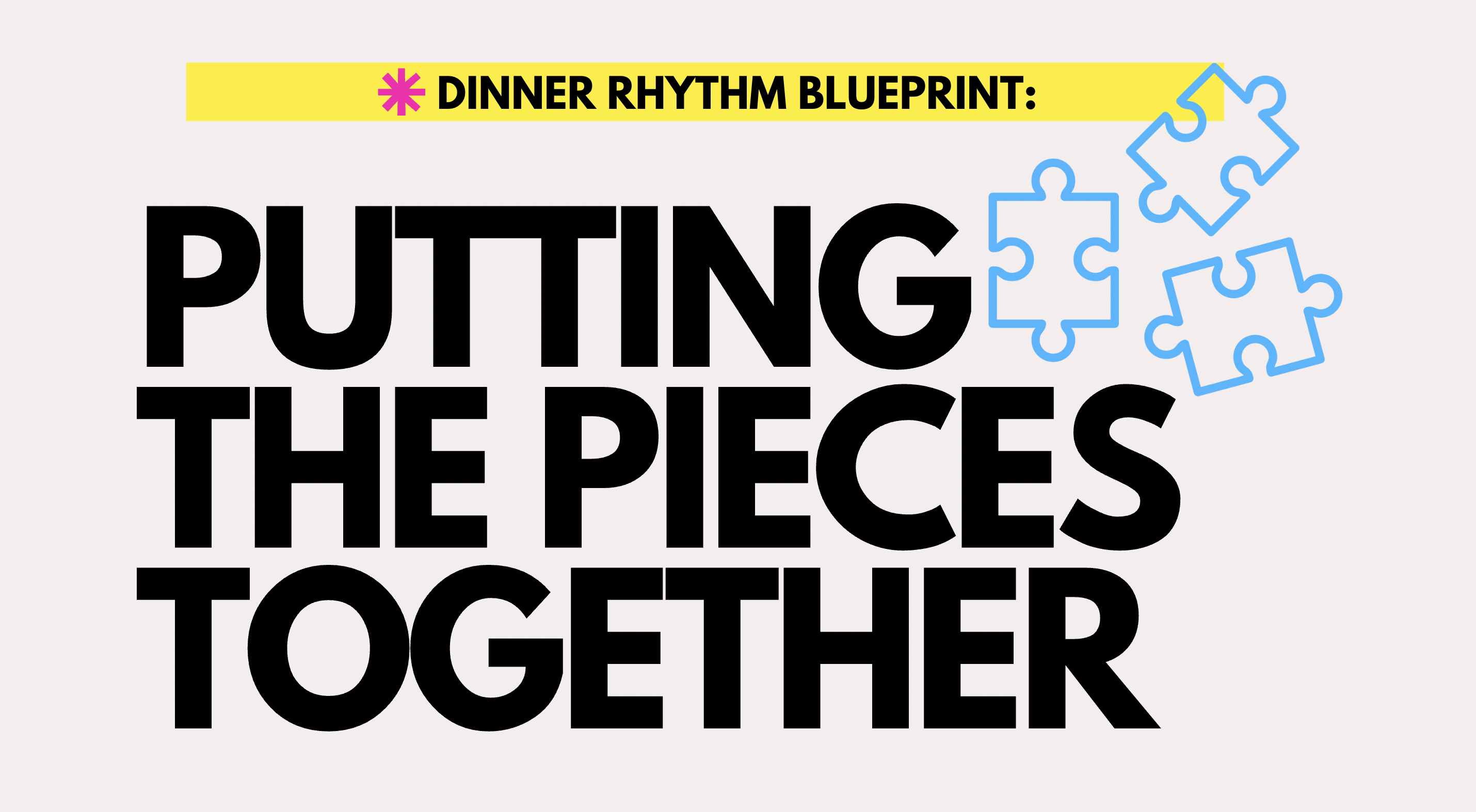
👉 This post is Part 5 of the Dinner Rhythm Blueprint series. If you missed the earlier steps, I recommend starting with Part 1: Dinner Rhythm Overview or heading to the full Dinner Rhythm Blueprint Hub to follow along in order. That way, you'll see how all the pieces build on each other and flow together into your first dinner rhythm.
🎥 Watch: How to Finalize Your Dinner Rhythm 👇👇
This is the video you don't want to skip. I walk you through how to pull everything you've learned so far into one clear, repeatable weekly rhythm.
👉 You can watch it or listen podcast-style while you fold laundry. But don't scroll past-this is where all the pieces snap together. Press play now 👇👇
You Made It! (And I'm Proud)
Well here we are!!! - you made it to the end of the Dinner Rhythm Blueprint.
👏 I am so proud of you for sticking with this process.
You didn't just skim a blog post or click "save" on Pinterest. You've actually built a real, working system that fits your energy, your family, and your real life.
This isn't about following some random meal plan that doesn't work. It's about building something with staying power. Something that actually supports you.
Quick Recap of the Journey
Let's pause and celebrate how far you've come. Here's what you've already done in the Blueprint:
✅ You took the What's Left in the Tank Test → now you know how much energy you realistically have on different nights (10 tired-night dinner ideas).
✅ You created a Family Flavor Map → factoring in your family's favorites, dislikes, and allergies-no more guessing.
✅ You filled out the Dinner Sanity Quadrant → spotting which meals are worth repeating and which to retire (What's For Dinner? The Question That Stresses Us Out).
✅ You built a list of Anchor Meals → those reliable, autopilot dinners you can always count on (Anchor Meals guide).
✅ You chose your Grace Nights → planned "do less" nights that give you space to rest (Grace Nights explained).
✅ You created your Emergency Dinner Backup List → the chaos-proof safety net of dinners you can whip up with pantry or freezer staples (65 Emergency Dinners).
💛 Honestly? That's a LOT. Most people never get this far. But you? You've laid the foundation for a rhythm that will keep working for you week after week..
What a Dinner Rhythm Actually Looks Like
So what is a Dinner Rhythm, really?
It's not another complicated plan. It's not forcing yourself to try 7 new recipes every week.
👉 At its core, it's just:
- Look at your week (activities + energy).
- Match the right kind of meal to the right night.
- Repeat. Let it get easier over time.
That's it. Simple. Doable. Sustainable.
Step 1: Pull Out Your Dinner Rhythm Worksheet
This worksheet is the hub of your rhythm. Print a few copies and keep them handy.
On it, you'll:
- Keep your Emergency Dinners list nearby as backups.
- Write down your activities for each day.
- Note your energy level (high / medium / low).
- Decide if it's an Anchor Meal or a Grace Night.
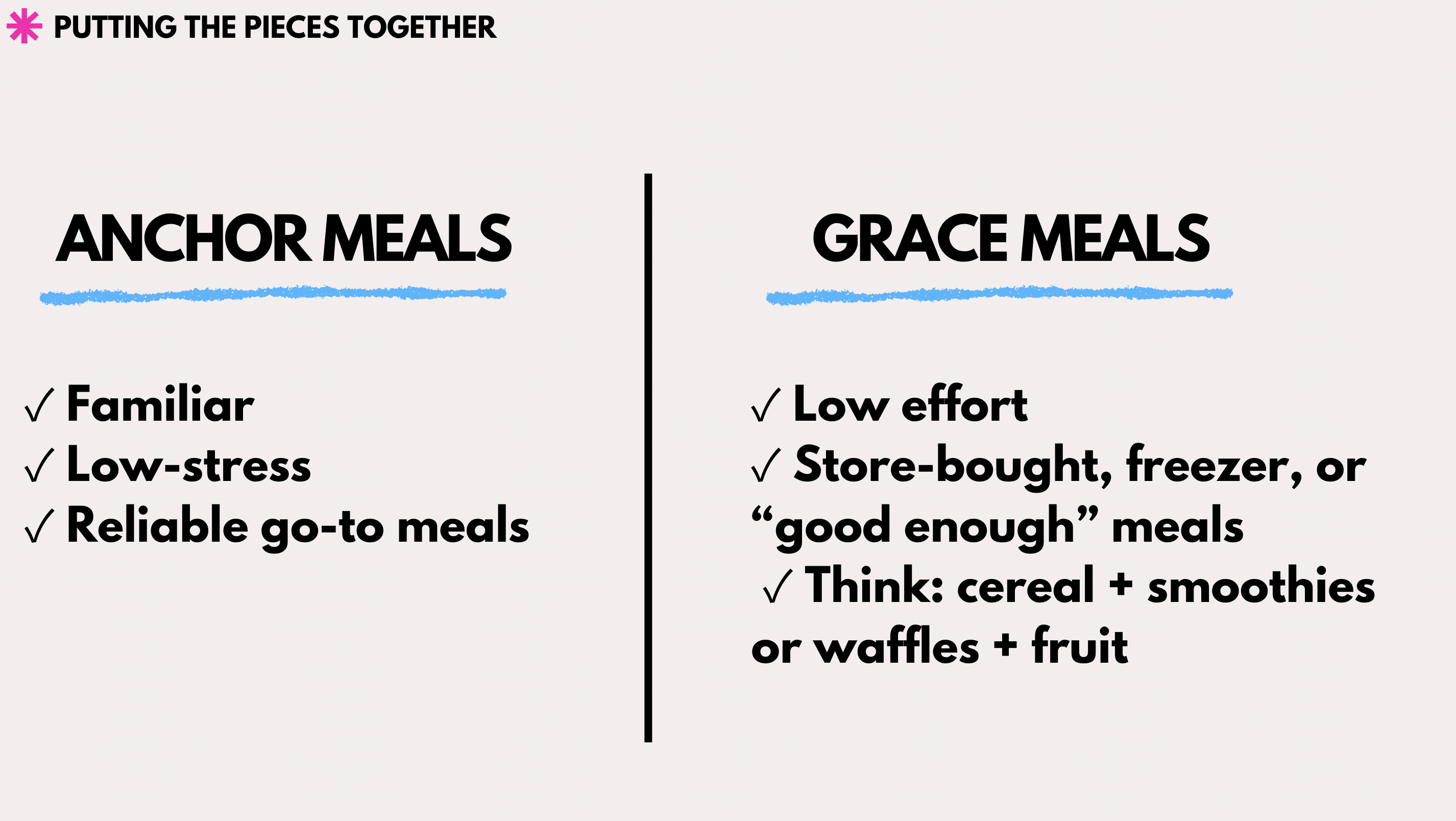
Step 2: Add in Your Anchors & Grace Nights
Anchor Meals → These are the meals you can make on autopilot. Tacos, pasta, burgers, sheet pan chicken, one-pot dinners, or budget-friendly meals.
Grace Nights → Your built-in permission slips. Frozen waffles, cereal for dinner, sandwiches, leftover nights, or even takeout (see more Grace Night ideas).
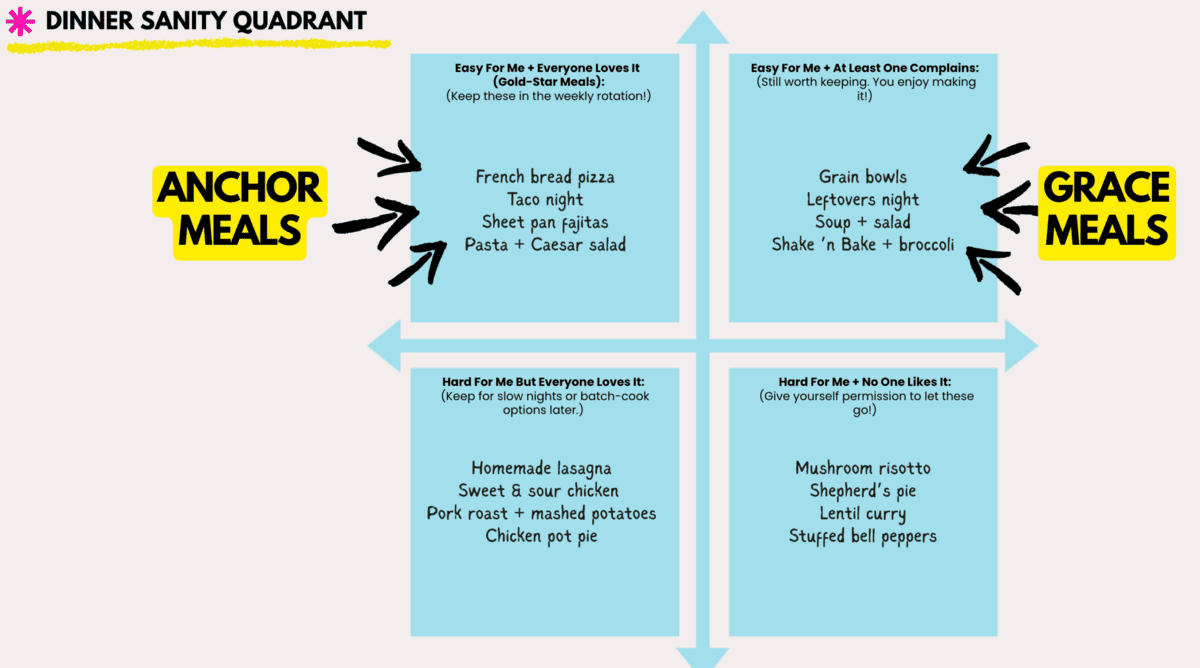
👉 Together, Anchors + Grace Nights form the bones of your rhythm.
Remember: Grace Nights aren't failures-they're intentional rest.
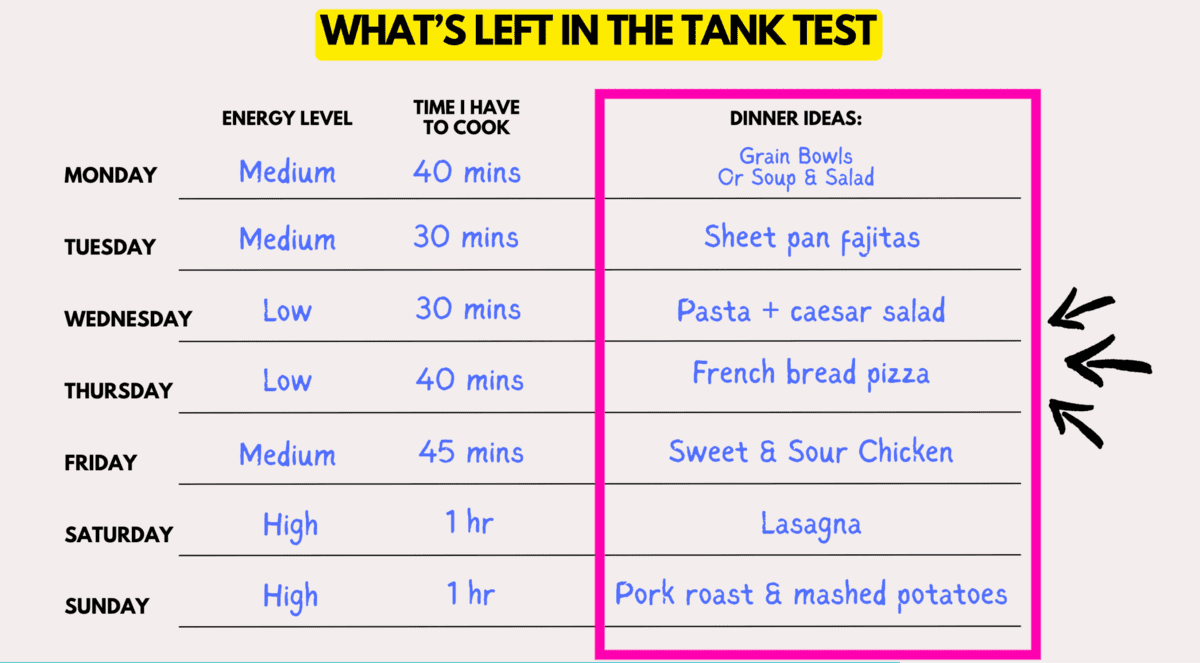
Step 3: Use Your Quadrant + Tank Test
This is where your earlier work makes dinner smarter:
- Use your Dinner Sanity Quadrant to choose meals that balance effort + enjoyment (stretch leftovers here).
- Use your What's Left in the Tank Test to match meals to your energy. If Thursdays always drain you, that's where freezer meals that don't taste like leftovers or quick dinner shortcuts go.
👉 No more guessing. You're now choosing dinners based on real information.
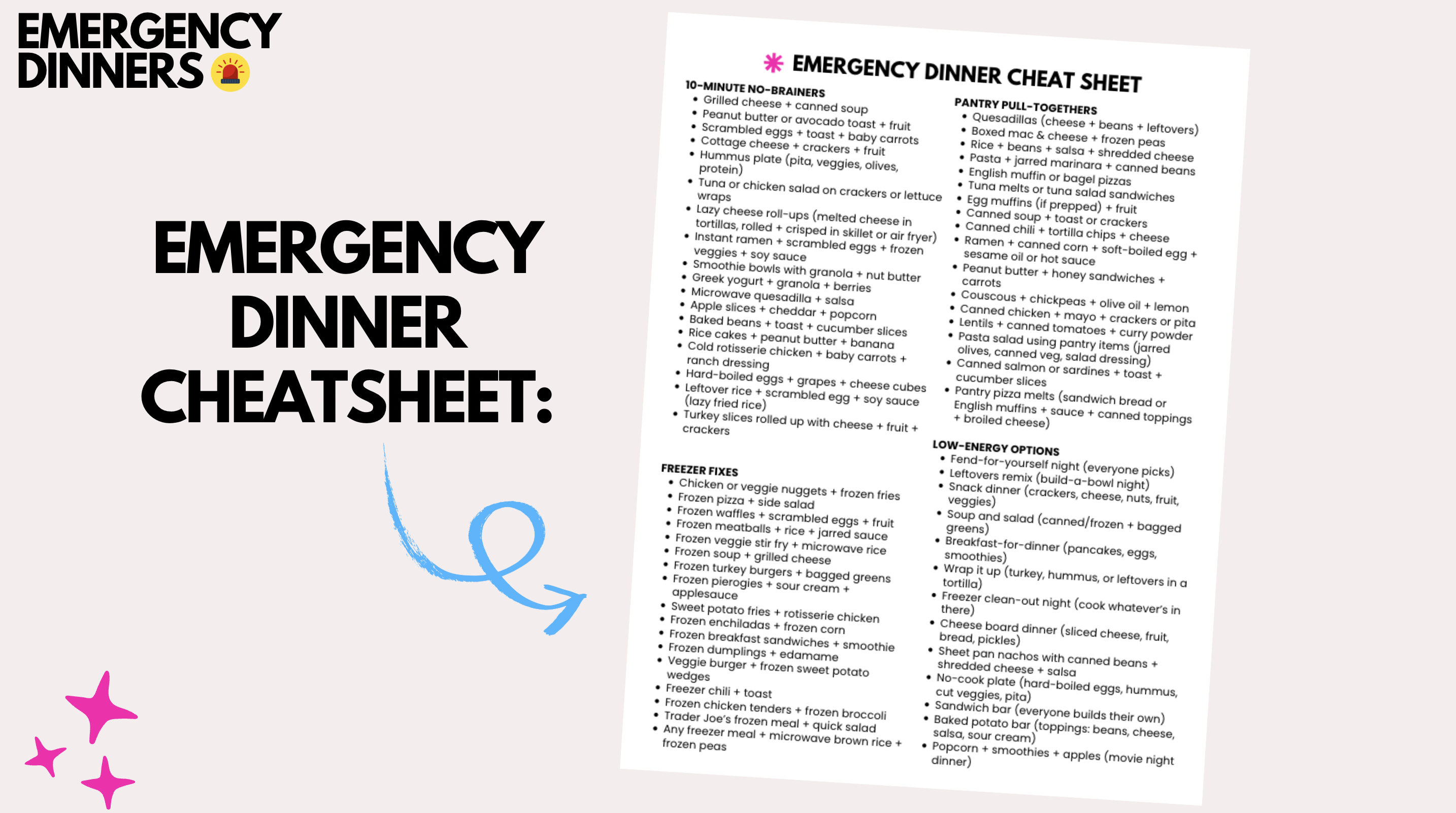
Step 4: Add Emergency Dinner Backups
Even the best rhythm needs a safety net.
Choose 2-3 Emergency Dinners to keep stocked each week. These are the meals you can always rely on: grilled cheese + soup, nuggets + fries, rice + beans, cereal for dinner.
👉 NOTE: Grab my free Emergency Dinner list for 65 ideas you can stick on your fridge.
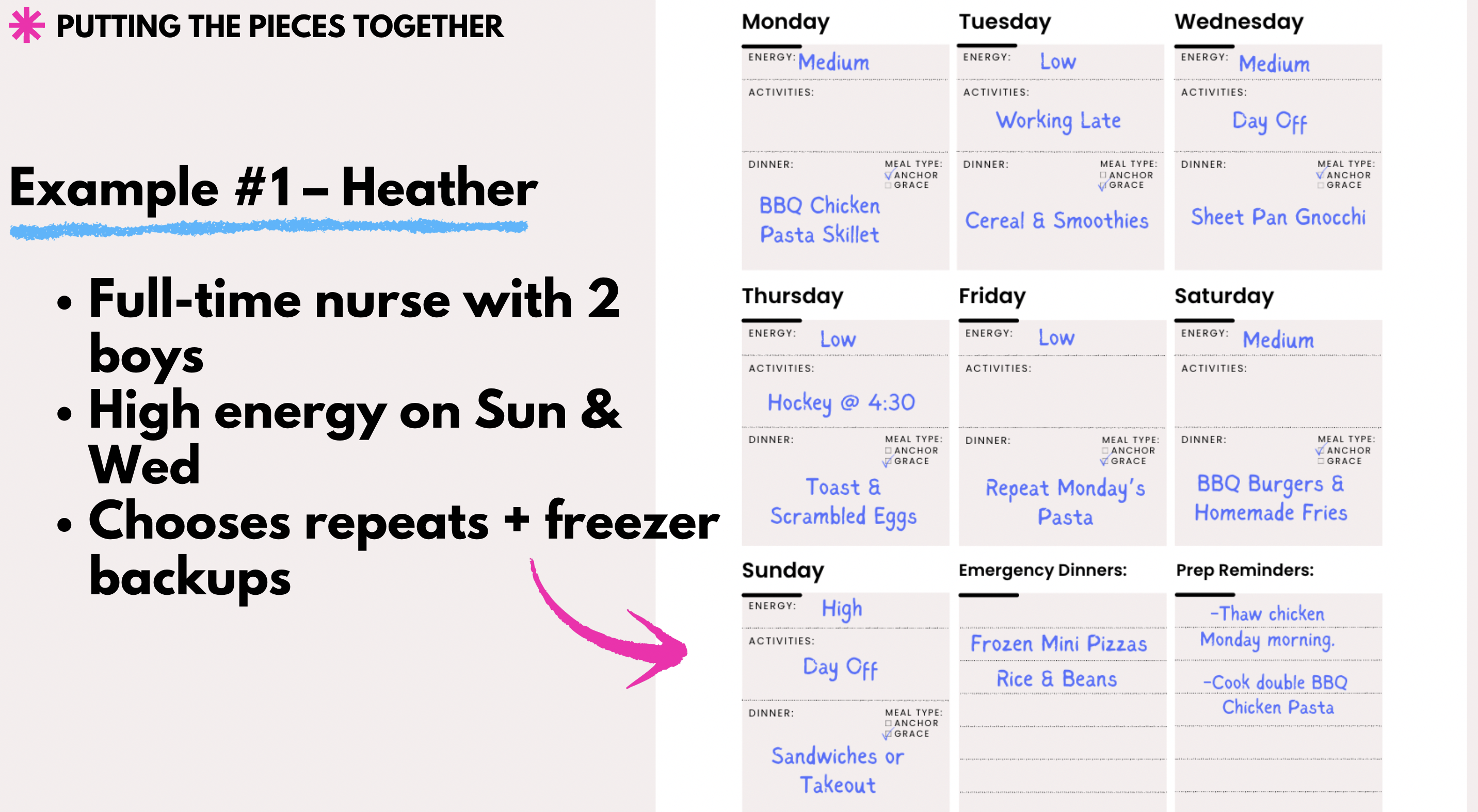
Real-Life Examples
Let's make this concrete. Here's what it looks like in action:
Example 1: The Over-It Mom
Heather is a full-time nurse with two boys. By the time she gets home, she's done with winging dinner. Her rhythm looks like this:
- Monday → Anchor Meal: BBQ Chicken Pasta Skillet
- Tuesday → Grace Night: Cereal + Smoothies
- Wednesday → Anchor Meal: Sheet Pan Gnocchi
- Thursday → Grace Night: Toast + Eggs
- Friday → Repeat Monday's Pasta
- Saturday → Anchor Meal: Burgers + Frozen Fries
- Sunday → Grace Night: Sandwiches or Takeout
Emergency Dinners: frozen pizzas + pantry beans/rice.
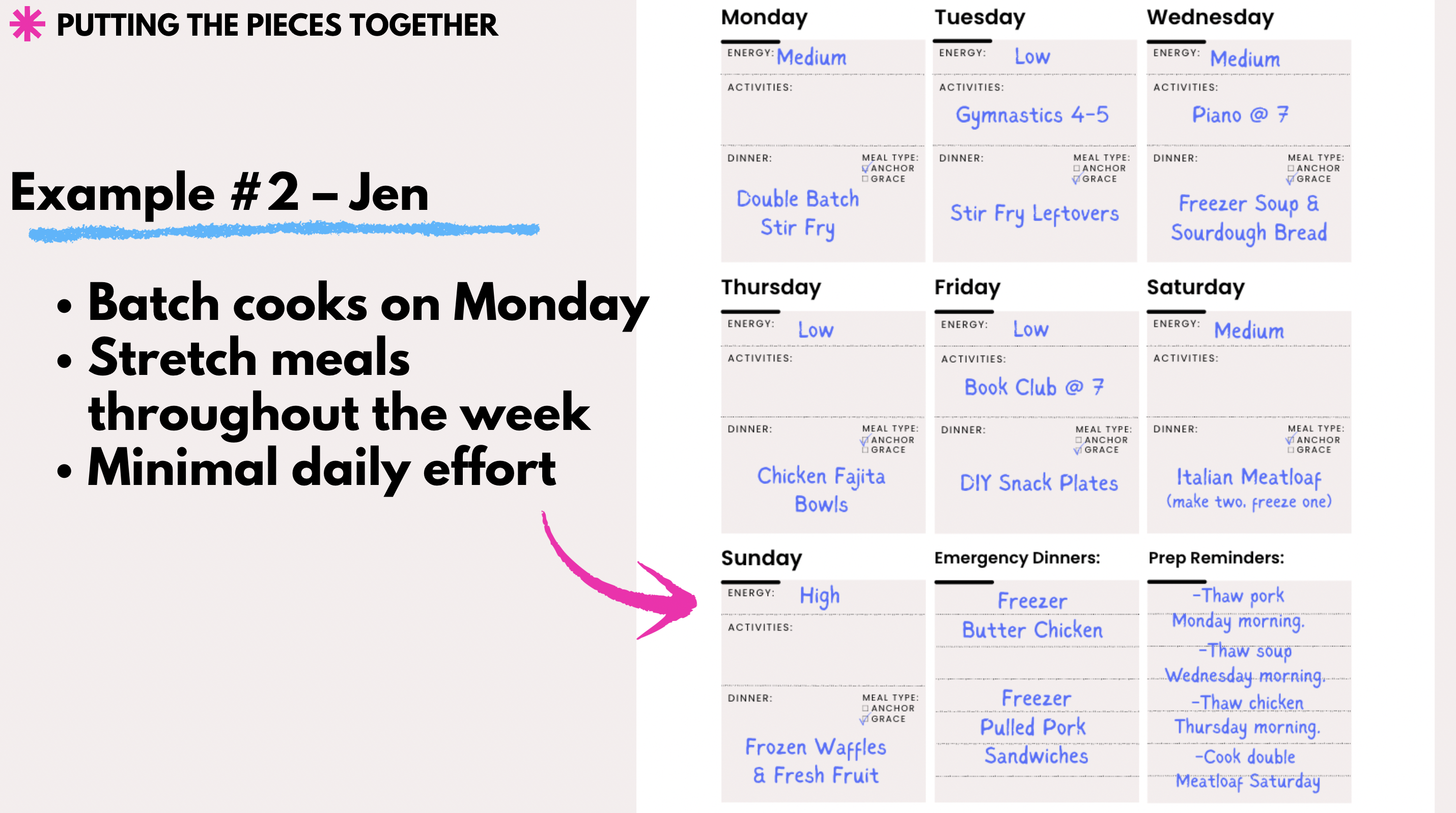
Example 2: The Batch-Cook Queen
Jen loves batch cooking. She wants to cook less, stretch meals more.
- Monday → Anchor Meal: Double Batch Stir Fry
- Tuesday → Repeat Monday's Stir Fry
- Wednesday → Grace Night: Freezer Soup + Bread
- Thursday → Anchor Meal: Chicken Fajita Bowls
- Friday → Repeat Soup or DIY Snack Plates
- Saturday → Anchor Meal: Baked Meatloaf (freeze one for later)
- Sunday → Grace Night: Frozen Waffles + Fruit
Emergency Dinners: Crockpot freezer meals prepped ahead.
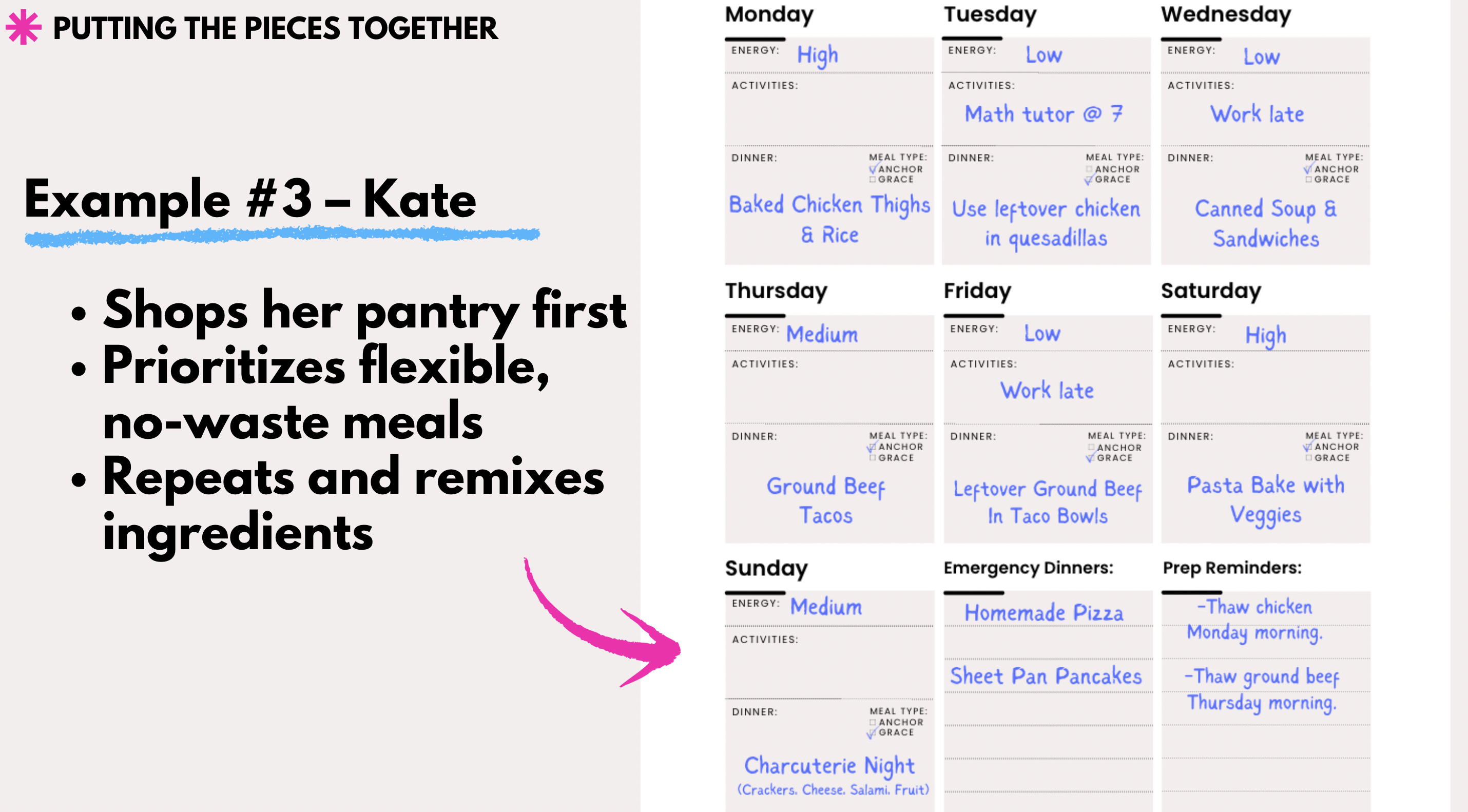
Example 3: The Use-What-I-Have Mom
Kate shops her pantry first to stay on budget.
- Monday → Anchor Meal: Baked Chicken Thighs + Rice
- Tuesday → Repeat Monday's Chicken (in quesadillas)
- Wednesday → Grace Night: Canned Soup + Sandwiches
- Thursday → Anchor Meal: Ground Beef Tacos
- Friday → Repeat Thursday's Tacos (in bowls)
- Saturday → Anchor Meal: Pasta Bake
- Sunday → Grace Night: No-Cook Snack Plate
Emergency Dinners: Frozen pizza dough, jarred pasta sauce, sheet pan pancakes.
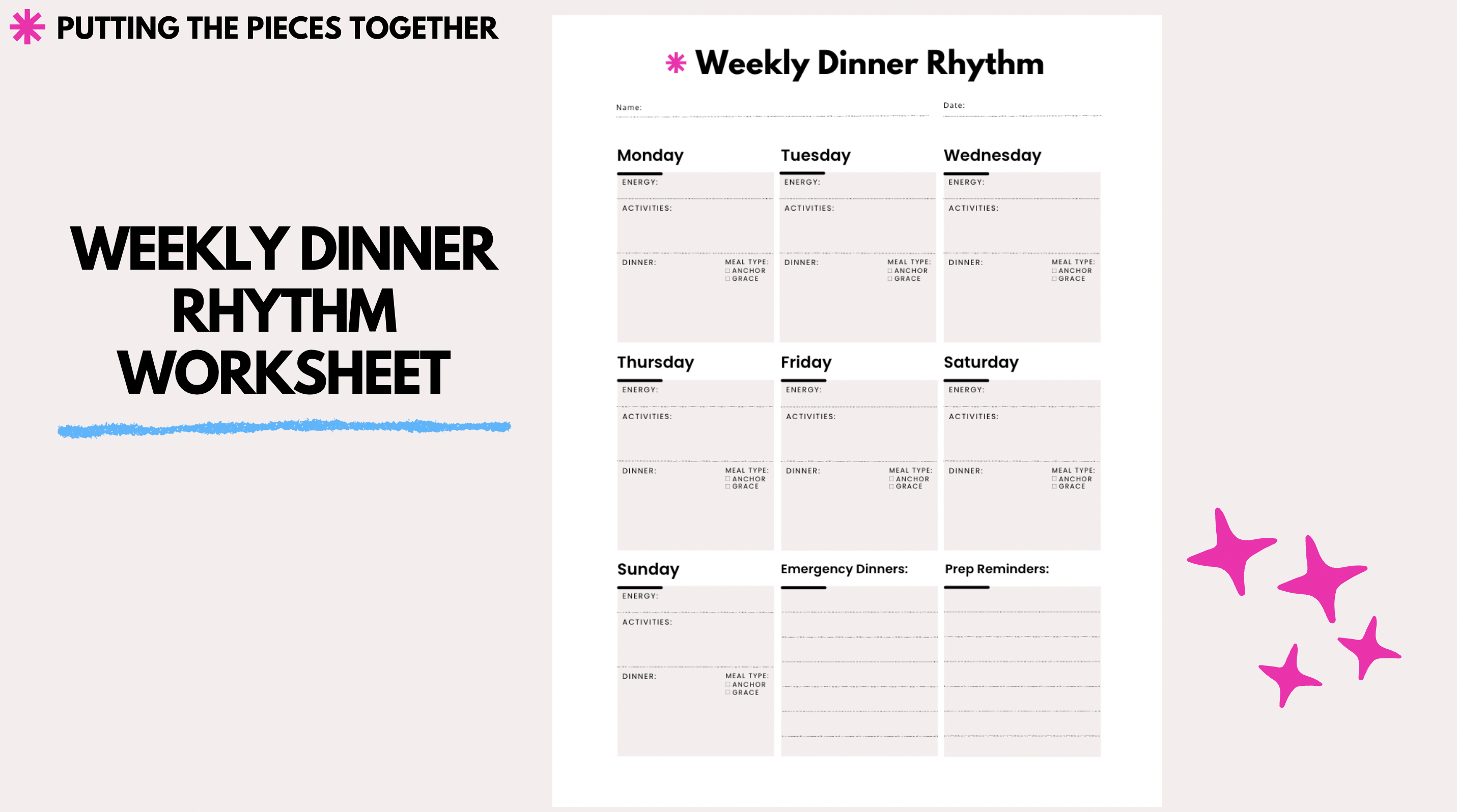
Step 5: Shop + Prep
Once your rhythm is filled in, here's how to make it work:
- Saturday/Sunday: Do your grocery shop.
- Attach the grocery list to the back of your rhythm worksheet.
- Sunday night: Review Monday's dinner. Do you need to thaw chicken? Chop veggies?
- Each evening: Take 2 minutes to glance at the next day. Pull what you need, prep anything quick.
This is how dinner goes from chaos to autopilot.
🎯 What To Do Next
You've built your first Dinner Rhythm - now it's time to put it into motion.
- Print your Dinner Rhythm template. Keep a few copies handy so you're never starting from scratch.
- Fill it in with the pieces you've already created. Add your activities, jot down your energy levels, plug in Anchor Meals and Grace Nights, and keep your Emergency Dinners list close.
- Make a grocery list. Attach it to your rhythm sheet so you've got everything you need for the week ahead.
- Start this week. Don't wait for the "perfect" Monday. Start with what you have right now.
- Stick with it for two weeks. Give your rhythm time to settle in. Let it feel awkward, let your family adjust, let you adjust. Then tweak as needed.
👉 And remember: this isn't about perfection. If you miss a day, lean on your Emergency Dinners. If the rhythm feels clunky, make a small swap. It will smooth out the more you repeat it.

FAQs: Your Top Questions About Dinner Rhythm Blueprint, Answered
Nope. Not even close.
Some members plan 5 dinners and repeat two. Others plan 3 and leave room for leftovers, takeout, or whatever's easiest.
The goal isn't to fill every box-it's to create enough structure that you stop reinventing the wheel every night.
You can repeat them-and you should.
Repetition is what makes this feel doable. Most families cycle through 8-12 meals regularly anyway, even if they don't realize it.
And let's be real: your kids probably wouldn't complain about tacos every Tuesday or pasta twice a week. When dinner feels easier, everyone wins.
That's exactly why we build out your Emergency Dinner List.
These are your backup plans for the nights when life falls apart.
Think: grilled cheese, frozen nuggets, cereal, peanut butter toast. It's not gourmet-it's strategic. And it counts. Always.
You don't need a big announcement. Start small.
Choose one or two Anchor Meals you know they love and build from there.
Use fun names like "Snack Plate Saturdays" or "Build-Your-Own Taco Night" to get kids excited.
When dinner feels calmer, they'll feel the difference too.
That's normal. That's life.
This isn't a rigid plan-it's a pattern. You can pause and pick it back up anytime.
Start small. Reuse what worked. Let the rhythm be flexible. You're not behind-you're building something that lasts.
Absolutely.
Theme nights are a great way to reduce decision fatigue.
They also make your rhythm easier to remember and reuse.
Just don't overthink it-pick a few that feel natural for your family and roll with it.
Definitely not.
Rotisserie chicken? Counts. Jarred pasta sauce? Counts.
Frozen broccoli? Big yes.
This rhythm is about getting dinner done-not proving anything on Instagram.
Yes, and here's the secret:
When dinner feels less chaotic, it becomes easier to make intentional choices.
You can absolutely build a rhythm around simple, nourishing meals. Start where you are, and layer in small shifts that work for your family.
Whenever something feels off-or you get bored.
Maybe school starts, your work schedule shifts, or your kids suddenly decide they hate tacos.
That's your cue. Your rhythm is meant to evolve with you. Just come back to your worksheet and adjust as needed.
You're not alone.
This system was designed for people who are tired of dinnertime stress and don't want to live in the kitchen.
Anchor Meals, Grace Nights, and Emergency Dinners exist so you can feed your family without needing to "enjoy" cooking every night.
You don't have to love cooking to build a rhythm that works.
You can add variety after your rhythm is solid.
For now, reuse your anchor meals and plug in one new recipe at a time if you want to experiment.
The key is: don't change everything at once. Keep 80% repeatable, and switch up the rest slowly.
Here's the easiest way to tell:
🧱 Anchor = Familiar + Effort You Can Handle
🌿 Grace = Little Effort To Make and You Planned To Make Them That Day
⚡ Emergency = Last Minute Decistion Meals That Feed People Fast (even if it's cereal)
You'll know based on how it feels to make it.
Usually 2-3 weeks.
You'll notice mental relief almost immediately (because decision fatigue goes way down).
But the rhythm itself gets stronger as you reuse it.
By week 3, it starts to feel like autopilot-and that's the goal.
Nope. You adjust, not restart.
Your rhythm is a flexible tool, not a rigid plan.
Change one meal. Swap a night. Shift your Grace Night to Saturday instead of Friday.
Small tweaks = big long-term wins.
If your weekly routine changes a lot between seasons-yes.
You might want a "school rhythm" and a "summer rhythm."
They don't need to be totally different-just enough to match your energy, schedule, and what your days actually look like.
You don't need your week to be predictable.
That's why this system focuses on flexibility.
If Mondays are always different, just pick a meal that's always easy (like sandwiches or pasta).
Leave wiggle room. Add emergency meals. Let your rhythm support the chaos-not fight it.
That comes next.
Once your rhythm feels natural, you can layer in things like prepping a few ingredients ahead or making double batches.
But don't rush it. Get the rhythm down first-then we'll talk time-savers and freezer hacks.
If your partner helps with meals-yes, share it!
Even posting it on the fridge can cut down the "what's for dinner?" questions.
But if you're the main cook, this can also be your personal roadmap.
It's totally up to you. The rhythm is yours to use however it helps most.
Yes!
Download the printable Weekly Dinner Rhythm Template below. It's designed to be used over and over-just fill it in based on your week and your energy.
Then simplify more.
Cut it down to 3 dinners max. Use the same 3 for two weeks.
This isn't about building the perfect plan-it's about building a usable one. If you never follow it, it's too complicated. Shrink it until it feels laughably easy.
Yes!
Dinner rhythm isn't about quantity-it's about removing friction.
Even one planned night can save your sanity.
Use it how it fits your life right now.
That's okay.
Start with what your family actually eats-then you can evolve from there.
Anchor Meals are your entry point. They don't have to be perfect to be powerful.
Put it where you'll see it.
Fridge, whiteboard, digital calendar, reminder app-whatever works for you.
This rhythm is a support system, not another thing to keep track of. Make it visible and easy to reference.
Absolutely.
Dinner rhythm is about knowing what's for dinner-not about who made it.
If a takeout night keeps you sane or a frozen lasagna gives you a break, that's rhythm at work.
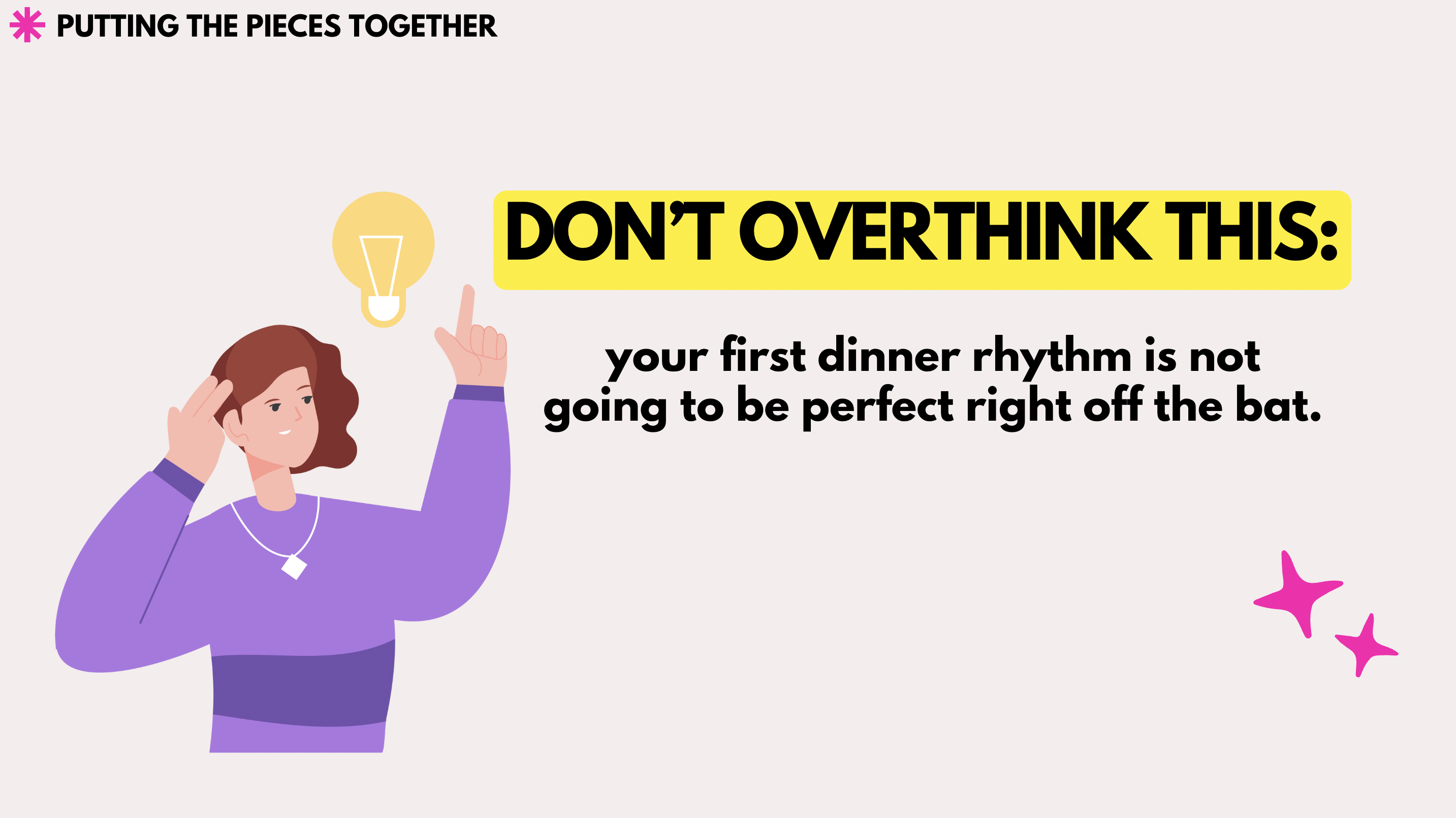
Final Thoughts
You did it 🙌 You built your first real dinner rhythm.
And it's not just a plan. It's a system.
One that bends when life bends. One that gives you rest on the hard days, structure on the steady days, and a safety net on the chaos days.
Dinner doesn't need to be impressive. It just needs to be done.
👉 If you haven't yet, grab your Dinner Rhythm Blueprint worksheets and start filling in your first rhythm today.
You don't need more willpower. You just need a rhythm that works with you, not against you. And now? You've got it. 💛
Dinner Rhythm Blueprint: Here's Your Roadmap 👇👇
📌 Part 1: Dinner Rhythm Overview
📌 Part 2: What's Left in the Tank Test
📌 Part 3: The Dinner Sanity Quadrant
📌 Part 4: The Dinner Rhythm Toolbox
📌 Part 5: Finalizing Your Dinner Rhythm (You Are Here 📌)
👉 Want the big picture? Start from the beginning on the Dinner Rhythm Blueprint Hub


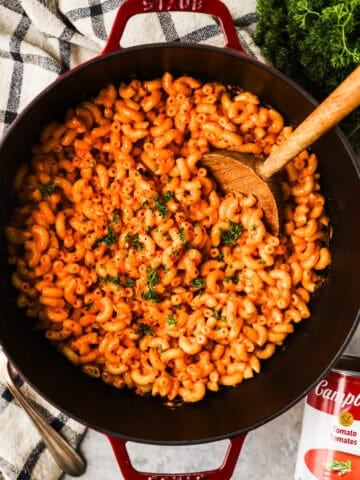
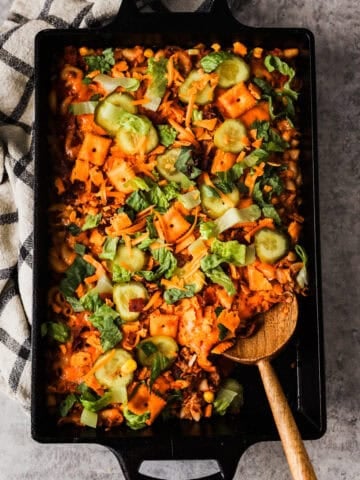
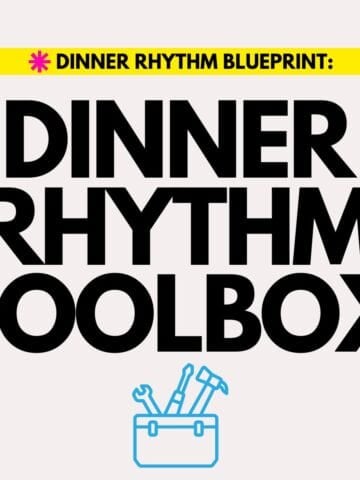
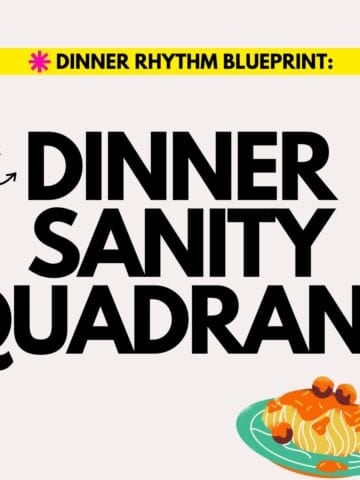
Leave a Reply